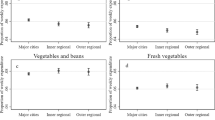Abstract
Objective: To discuss the general outcome and conclusions of a European project (EFCOSUM); to develop a method for a European food consumption survey that delivers internationally comparable data on a set of policy relevant nutritional indicators.
Design and methods: The EFCOSUM project was carried out within the framework of the European Health Monitoring Programme by 14 Member States as well as nine other European countries. Activities of the project included plenary sessions, desk research and working group activities, building on existing experience from such projects as DAFNE, EPIC, FLAIR Eurofoods-Enfant project, COST Action 99 and others. All participating states took part in one or more working group activities, which were discussed, adapted and finally approved in plenary sessions.
Results and conclusions: For a limited number of countries available food consumption data can be made comparable at the food intake level, but not at the nutrient level. To achieve comparability at the food intake level, a considerable amount of work still has to be done. A minimum list of dietary indicators considered to be the most relevant to be collected for the Health information exchange and monitoring system was identified. As the most suitable method to get internationally comparable new data on population means and distributions of actual intake the 24 h recall was selected, to be conducted at least twice. This also allows for the estimation of usual intake by a modelling technique that separates intra- and inter-individual intake. For a number of micronutrients the use of biomarkers is recommended. Aspects of food classification and food composition were discussed thoroughly, as well as statistical and data collection aspects. For the implementation of a pan-European survey the establishment of a European co-ordinating centre is recommended. The standardization of field work work procedures and other aspects of operationalization have been discussed in detail. It is concluded that there is broad European consensus on the most suitable method for a pan-European dietary survey for the purposes of the EU Health Monitoring Programme. It is further concluded that such a pan-European survey is feasible, if the funds are made available.
Sponsorship: European Commission, DG SANCO F/3, Health Monitoring Programme.
This is a preview of subscription content, access via your institution
Access options
Subscribe to this journal
Receive 12 print issues and online access
$259.00 per year
only $21.58 per issue
Buy this article
- Purchase on Springer Link
- Instant access to full article PDF
Prices may be subject to local taxes which are calculated during checkout
Similar content being viewed by others
Author information
Authors and Affiliations
Consortia
Corresponding author
Rights and permissions
About this article
Cite this article
Brussaard, J., Löwik, M., Steingrímsdóttir, L. et al. A European food consumption survey method–conclusions and recommendations. Eur J Clin Nutr 56 (Suppl 2), S89–S94 (2002). https://doi.org/10.1038/sj.ejcn.1601432
Published:
Issue Date:
DOI: https://doi.org/10.1038/sj.ejcn.1601432
Keywords
This article is cited by
-
Dietary exposure assessment to food additives: a critical review of food consumption surveys
Nutrire (2024)
-
Optimism is associated with diet quality, food group consumption and snacking behavior in a general population
Nutrition Journal (2020)
-
How dietary patterns affect left ventricular structure, function and remodelling: evidence from the Kardiovize Brno 2030 study
Scientific Reports (2019)
-
Road map towards a harmonized pan-European surveillance of obesity-related lifestyle behaviours and their determinants in children and adolescents
International Journal of Public Health (2019)
-
Dietary sources of sugars in adolescents’ diet: the HELENA study
European Journal of Nutrition (2018)



